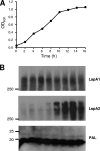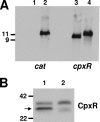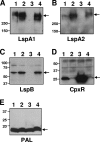Regulation of expression of the Haemophilus ducreyi LspB and LspA2 proteins by CpxR
- PMID: 19451237
- PMCID: PMC2715676
- DOI: 10.1128/IAI.00292-09
Regulation of expression of the Haemophilus ducreyi LspB and LspA2 proteins by CpxR
Abstract
The LspA1, LspA2, and LspB proteins of Haemophilus ducreyi comprise a two-partner secretion system that has been shown to be necessary for H. ducreyi to inhibit phagocytosis by immune cells in vitro. Inactivation of lspA1 resulted in increased levels of LspA2, suggesting that these two proteins are differentially controlled (C. J. Ward et al., Infect. Immun. 71:2478-2486, 2003). Expression of LspA2 but not LspA1 was shown to be both growth phase dependent and affected by the presence of fetal calf serum (FCS) in the growth medium. In addition, neither LspA1 nor LspA2 could be detected in culture supernatant fluid in the absence of FCS. DNA microarray analysis revealed that 324 H. ducreyi genes were differentially regulated after growth in the presence of FCS. Among these, the CpxRA two-component sensory transduction system was downregulated by the presence of FCS. Inactivation of cpxR resulted in increased expression of both LspB and LspA2. Electrophoretic mobility shift assays showed that a recombinant H. ducreyi CpxR protein bound the promoter region of the lspB-lspA2 operon. The cpxR and cpxA genes were shown to be part of an operon containing two additional genes in H. ducreyi 35000HP. This is the first description of a two-component sensory transduction system regulating a proven virulence factor of H. ducreyi.
Figures






Similar articles
-
The LspB protein is involved in the secretion of the LspA1 and LspA2 proteins by Haemophilus ducreyi.Infect Immun. 2004 Apr;72(4):1874-84. doi: 10.1128/IAI.72.4.1874-1884.2004. Infect Immun. 2004. PMID: 15039306 Free PMC article.
-
Characterization of the CpxRA regulon in Haemophilus ducreyi.Infect Immun. 2010 Nov;78(11):4779-91. doi: 10.1128/IAI.00678-10. Epub 2010 Aug 30. Infect Immun. 2010. PMID: 20805330 Free PMC article.
-
The Haemophilus ducreyi Fis protein is involved in controlling expression of the lspB-lspA2 operon and other virulence factors.Infect Immun. 2013 Nov;81(11):4160-70. doi: 10.1128/IAI.00714-13. Epub 2013 Aug 26. Infect Immun. 2013. PMID: 23980107 Free PMC article.
-
Inhibition of phagocytosis by Haemophilus ducreyi requires expression of the LspA1 and LspA2 proteins.Infect Immun. 2003 Oct;71(10):5994-6003. doi: 10.1128/IAI.71.10.5994-6003.2003. Infect Immun. 2003. PMID: 14500520 Free PMC article.
-
Interactions of the Skin Pathogen Haemophilus ducreyi With the Human Host.Front Immunol. 2021 Feb 3;11:615402. doi: 10.3389/fimmu.2020.615402. eCollection 2020. Front Immunol. 2021. PMID: 33613541 Free PMC article. Review.
Cited by
-
Fis is essential for capsule production in Pasteurella multocida and regulates expression of other important virulence factors.PLoS Pathog. 2010 Feb 5;6(2):e1000750. doi: 10.1371/journal.ppat.1000750. PLoS Pathog. 2010. PMID: 20140235 Free PMC article.
-
Regulatory role of the Cpx ESR in bacterial behaviours.Virulence. 2024 Dec;15(1):2404951. doi: 10.1080/21505594.2024.2404951. Epub 2024 Sep 18. Virulence. 2024. PMID: 39292643 Free PMC article. Review.
-
A Haemophilus ducreyi CpxR deletion mutant is virulent in human volunteers.J Infect Dis. 2011 Jun 15;203(12):1859-65. doi: 10.1093/infdis/jir190. J Infect Dis. 2011. PMID: 21606544 Free PMC article.
-
The Haemophilus ducreyi LspA1 protein inhibits phagocytosis by using a new mechanism involving activation of C-terminal Src kinase.mBio. 2014 May 20;5(3):e01178-14. doi: 10.1128/mBio.01178-14. mBio. 2014. PMID: 24902122 Free PMC article.
-
Host-pathogen interplay of Haemophilus ducreyi.Curr Opin Infect Dis. 2010 Feb;23(1):64-9. doi: 10.1097/QCO.0b013e328334c0cb. Curr Opin Infect Dis. 2010. PMID: 19918177 Free PMC article. Review.
References
-
- Albritton, W. L., I. W. MacLean, P. D. Bertram, and A. R. Ronald. 1981. Haemin requirements in Haemophilus with special reference to H. ducreyi, p. 75-82. In M. Kilian, W. Frederiksen, and E. L. Biberstein (ed.), Haemophilus, Pasteurella, and Actinobacillus. Academic Press, London, England.
-
- Al Tawfiq, J. A., K. R. Fortney, B. P. Katz, A. F. Hood, C. Elkins, and S. M. Spinola. 2000. An isogenic hemoglobin receptor-deficient mutant of Haemophilus ducreyi is attenuated in the human model of experimental infection. J. Infect. Dis. 1811049-1054. - PubMed
-
- Anonymous. 2000. Primer3 on the WWW for general users and for biologist programmers, p. 365-386. In S. Krawetz and S. Misener (ed.), Bioinformatics methods and protocols: methods in molecular biology. Humana Press, Totowa, NJ. - PubMed
Publication types
MeSH terms
Substances
Grants and funding
LinkOut - more resources
Full Text Sources
Molecular Biology Databases

